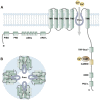The Multifaceted Functions of TRPV4 and Calcium Oscillations in Tissue Repair
- PMID: 38256251
- PMCID: PMC10816018
- DOI: 10.3390/ijms25021179
The Multifaceted Functions of TRPV4 and Calcium Oscillations in Tissue Repair
Abstract
The transient receptor potential vanilloid 4 (TRPV4) specifically functions as a mechanosensitive ion channel and is responsible for conveying changes in physical stimuli such as mechanical stress, osmotic pressure, and temperature. TRPV4 enables the entry of cation ions, particularly calcium ions, into the cell. Activation of TRPV4 channels initiates calcium oscillations, which trigger intracellular signaling pathways involved in a plethora of cellular processes, including tissue repair. Widely expressed throughout the body, TRPV4 can be activated by a wide array of physicochemical stimuli, thus contributing to sensory and physiological functions in multiple organs. This review focuses on how TRPV4 senses environmental cues and thereby initiates and maintains calcium oscillations, critical for responses to organ injury, tissue repair, and fibrosis. We provide a summary of TRPV4-induced calcium oscillations in distinct organ systems, along with the upstream and downstream signaling pathways involved. In addition, we delineate current animal and disease models supporting TRPV4 research and shed light on potential therapeutic targets for modulating TRPV4-induced calcium oscillation to promote tissue repair while reducing tissue fibrosis.
Keywords: TRPV4; calcium oscillations; fibrosis; tissue repair.
Conflict of interest statement
The authors declare no conflict of interest.
Figures




Similar articles
-
Emergent Temporal Signaling in Human Trabecular Meshwork Cells: Role of TRPV4-TRPM4 Interactions.Front Immunol. 2022 Mar 31;13:805076. doi: 10.3389/fimmu.2022.805076. eCollection 2022. Front Immunol. 2022. PMID: 35432302 Free PMC article.
-
TRPV4-mediated calcium signaling in mesenchymal stem cells regulates aligned collagen matrix formation and vinculin tension.Proc Natl Acad Sci U S A. 2019 Feb 5;116(6):1992-1997. doi: 10.1073/pnas.1811095116. Epub 2019 Jan 23. Proc Natl Acad Sci U S A. 2019. PMID: 30674675 Free PMC article.
-
When size matters: transient receptor potential vanilloid 4 channel as a volume-sensor rather than an osmo-sensor.J Physiol. 2017 Jun 1;595(11):3287-3302. doi: 10.1113/JP274135. Epub 2017 May 14. J Physiol. 2017. PMID: 28295351 Free PMC article.
-
Mini-review: Dissecting receptor-mediated stimulation of TRPV4 in nociceptive and inflammatory pathways.Neurosci Lett. 2022 Jan 23;770:136377. doi: 10.1016/j.neulet.2021.136377. Epub 2021 Nov 29. Neurosci Lett. 2022. PMID: 34856355 Review.
-
Roles for TRPV4 in disease: A discussion of possible mechanisms.Cell Calcium. 2024 Dec;124:102972. doi: 10.1016/j.ceca.2024.102972. Epub 2024 Nov 22. Cell Calcium. 2024. PMID: 39609180 Review.
Cited by
-
Viscoelastic hydrogel combined with dynamic compression promotes osteogenic differentiation of bone marrow mesenchymal stem cells and bone repair in rats.Regen Biomater. 2024 Nov 23;12:rbae136. doi: 10.1093/rb/rbae136. eCollection 2025. Regen Biomater. 2024. PMID: 39845143 Free PMC article.
-
Impact of TRP Channels on Extracellular Matrix Remodeling: Focus on TRPV4 and Collagen.Int J Mol Sci. 2024 Mar 22;25(7):3566. doi: 10.3390/ijms25073566. Int J Mol Sci. 2024. PMID: 38612378 Free PMC article. Review.
-
TRPV4-A Multifunctional Cellular Sensor Protein with Therapeutic Potential.Sensors (Basel). 2024 Oct 29;24(21):6923. doi: 10.3390/s24216923. Sensors (Basel). 2024. PMID: 39517820 Free PMC article. Review.
-
Curcumin protects against MPP+-induced neurotoxicity in SH-SY5Y cells by modulating the TRPV4 channel.Mol Biol Rep. 2025 Feb 20;52(1):255. doi: 10.1007/s11033-025-10345-1. Mol Biol Rep. 2025. PMID: 39976770
References
Publication types
MeSH terms
Substances
Grants and funding
LinkOut - more resources
Full Text Sources

